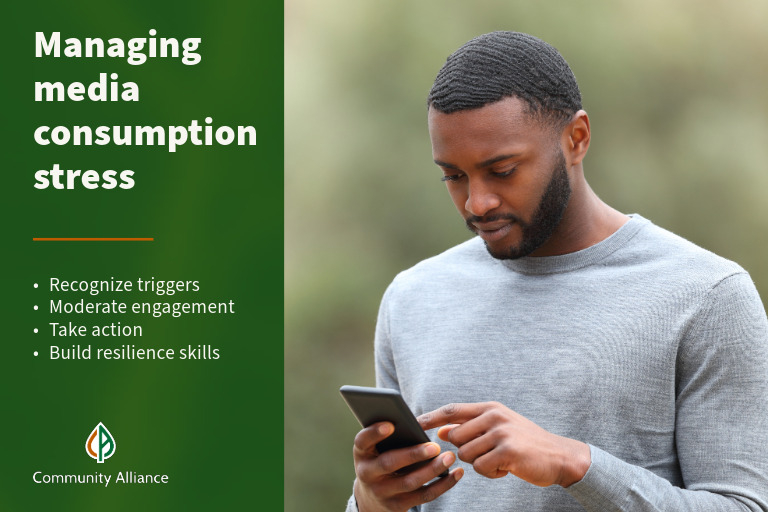How to manage the stress of media consumption to support our mental health

Constantly consuming news and information, especially through social media, can leave us feeling depleted and powerless. Even further, it can worsen mental health conditions like depression and paranoia. Stacy Ring, Community Alliance’s behavioral health and education manager, has witnessed how endless scrolling impacts people’s mental health.
“If you already have depression, and you’re consuming all this content, it can feed that depressive energy and intensify feelings of hopelessness,” said Stacy. “Social media can particularly feed people’s sense of inferiority or worthlessness.”
There’s no simple solution for the stresses of media consumption, but recognizing our triggers, moderating our engagement, taking action and building resiliency skills can help us manage our mental health.
Recognizing triggers
The causes we care about can often feel beyond our control. Recognizing which topics trigger our feelings of helplessness and setting realistic expectations for our sphere of influence can help protect our mental health. Individually, no one can completely solve an issue, such as animal welfare, but we can do what we can with what we have, such as fostering a pet or volunteering at a shelter.
Online content prioritizes clicks, fueling exaggerated headlines. Keeping this in mind can also help put news into perspective and reduce emotional triggers.
“News often doesn’t change as fast as the 24-hour news cycle,” said Stacy. “Seeing the same article repackaged with a different headline, or the same topic across multiple news sites, can make a story feel bigger or more frequent than it is.”
Moderating engagement
The balance between completely opting out and experiencing information burnout differs for everyone. Stacy advises to set limits and stick to them. Explore phone settings, timers or apps that can help limit screen time. Consider silencing notifications or turning off push notifications — many of which can wait — from social apps and news sites. To curb endless digital scrolling, try opting for print publications or TV news.
Identifying what can be experienced in person with others, such as going to a museum, instead of passively interacting with friends through social media grounds us in the “real world.” Establishing “no phone zones” during times of the day like dinner can help us stay connected to our loved ones.
Whether engaging with an app, social media platform, TV show or any other stress-inducing media source, ask, “How does this better me as a person? How does it add value to my life or help someone?” If it doesn’t, it may not be worth our time.
Taking action
Recognizing what we value and what’s in our control guides how we can take action to relieve feelings of powerlessness. Ask, “What can I do? What’s in my power? What skills do I have to help?”
Accumulating positive experiences is also important. We should connect with individuals and groups that affirm our values and help fill our bucket when negative information depletes it.
For people who are directly impacted by negative news and political decisions, Stacy encourages them to share their experiences, if safe to do so.
“Sharing your story gives other people in your sphere of influence the opportunity to understand your lived experience more fully. Not everyone will be open to changing their mind, but if they care about you, they may expand their perspective.”
Building resilience
There are ways to increase our resilience by focusing on emotional regulation, impulse control, empathy, optimism, causal analysis, self-efficacy and reaching out. No one is innately more or less resilient than others — by practicing these skills, we can strengthen our ability to maintain our well-being in the face of adversity. Stacy recommends “The Resilience Factor” by Karen Reivich as an introduction to learning these skills.



